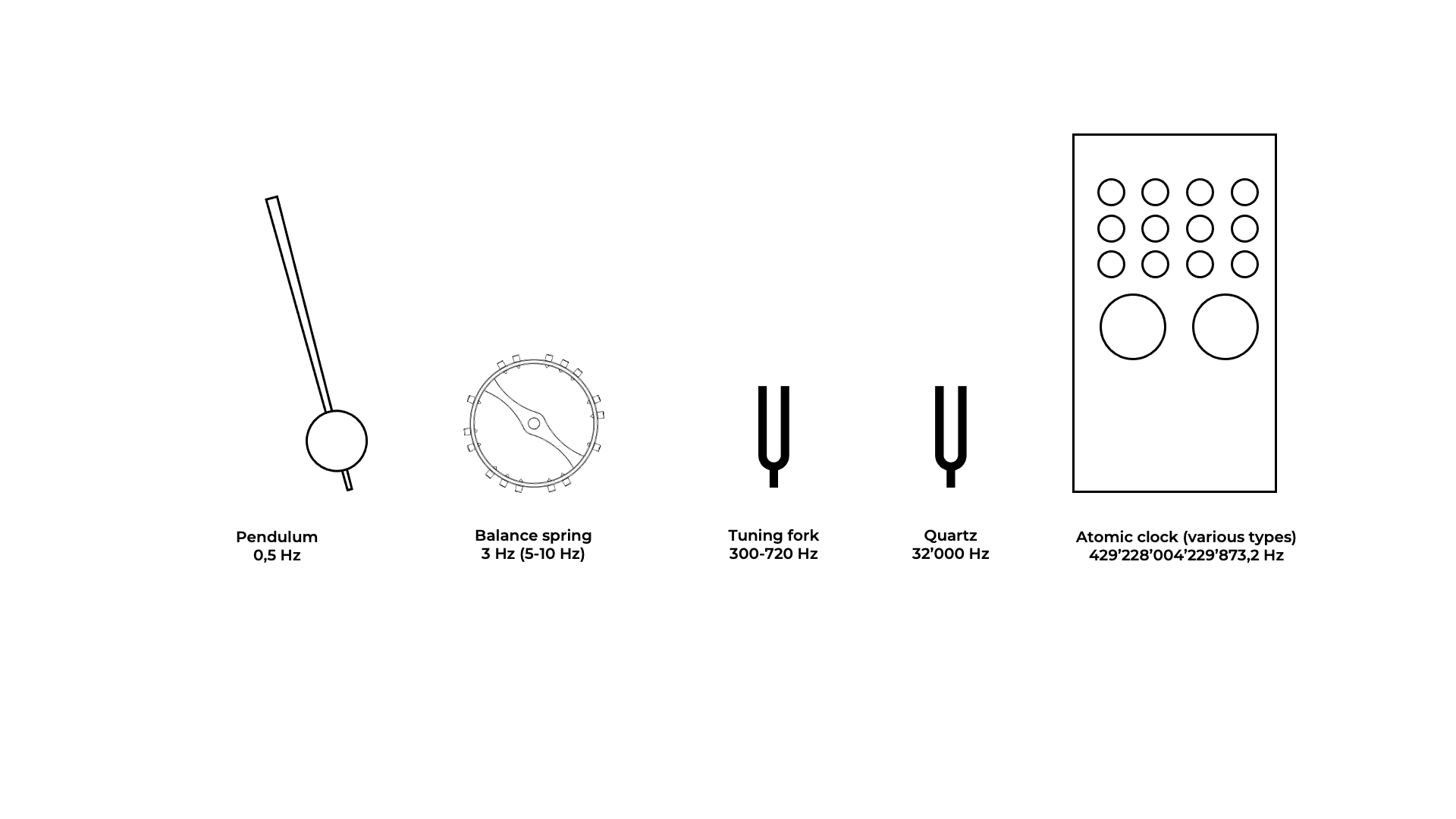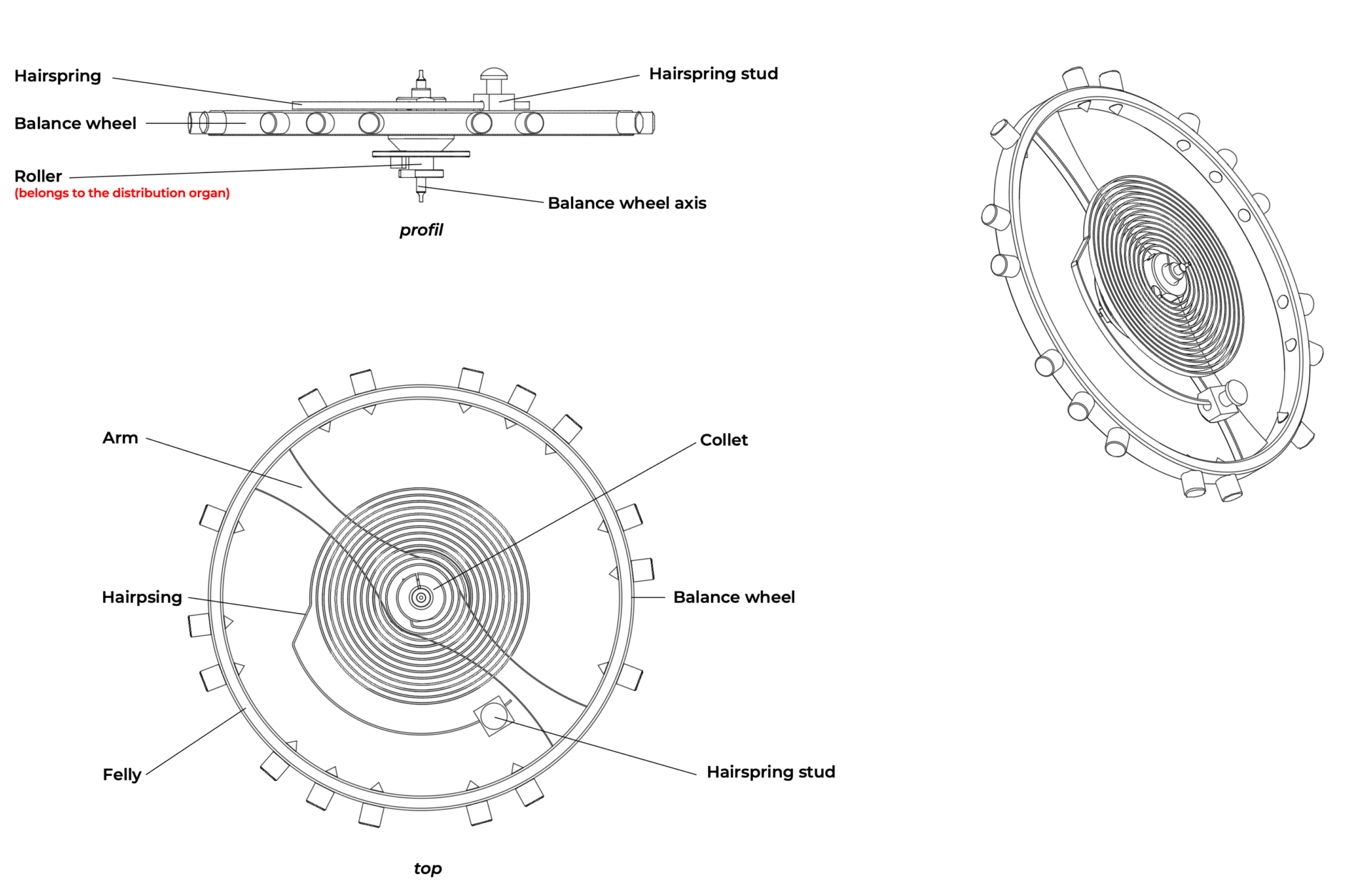REGULATING ORGAN
Definition
The regulating organ is the oscillating device that determines the cadence of a watch movement. In portable timepieces (pocket or wristwatches), the regulating organ is most often the balance-and-spring system, forming a harmonic oscillator whose period defines the accuracy of the watch. Acting as the true “beating heart” of the movement, it transforms the energy stored in the mainspring into a series of regular oscillations, thereby ensuring the consistency of time measurement.
Types of regulating organs
| Type of timekeeping instrument | Regulating organ | Frequency | Accuracy |
|---|---|---|---|
| Clocks | Pendulum | 0.5–1 Hz | – |
| Mechanical watches / clocks | Balance-spring | 5–10 Hz | approx. 5 s/day |
| Electronic watches | Tuning fork | 300–720 Hz | approx. 3 s/month |
| Electronic watches | Quartz crystal | 32,000 Hz | approx. 1 s/month |
| Atomic clocks | Atoms (various types) | 429,228,004,229,873.2 Hz | approx. 1 s/13 billion years |

Pendulum
The pendulum is the oldest mechanical oscillator. It consists of a rod with a suspended mass, the height of which is usually adjustable. Pendulums are present in the majority of clocks. In the early 17th century, Galileo observed that the period of a pendulum remained constant regardless of its amplitude (the theory of isochronism). This was later refined by Christiaan Huygens, who went on to invent the balance-spring. Pendulums achieve excellent chronometric performance but cannot operate while in motion, which excludes their use in portable horology. They generally oscillate at between 0.5 Hz and 1 Hz. Movements, shocks, and temperature variations can all affect the accuracy of pendulum-regulated clocks.
Balance-spring
The regulating organ of most mechanical portable timepieces is the balance-spring, invented in 1675 by Christiaan Huygens. This was a true revolution, enabling portable time measurement in marine chronometers, pocket watches, and later wristwatches. The balance-spring consists of a balance wheel acting as an inertia flywheel, and a fine spiral spring (hairspring). The oscillation frequency of a balance-spring is generally between 5 Hz and 10 Hz. This is the regulating organ that is be described in detail in this section.
Tuning fork
The tuning fork oscillator was used in early electronic watches powered by batteries. It consists of a steel blade shaped as a tuning fork, kept vibrating by an electromagnet through the piezoelectric effect. Such oscillators work within a range of 300–720 Hz. The vibrations of the tuning fork actuate pawls that drive the seconds wheel, so that the seconds hand makes 300 to 720 jumps per second, giving the illusion of continuous motion. Tuning fork watches were briefly popular in the early 1970s before being superseded by quartz technology. Owing to their technology and the frequency range (audible) of the tuning fork, these watches emit a characteristic high-pitched continuous hum.
Quartz
The principle of quartz oscillators is similar to that of tuning forks. A constant electric current makes a quartz crystal, cut in the form of a tuning fork, vibrate. By the piezoelectric effect, the crystal oscillates at a frequency of 32,000 Hz (32 kHz). The quartz transforms the direct current it receives into an alternating current of the same frequency. The electronic circuit of the movement then reduces this frequency to 1 Hz to drive the step motor of the watch.
Atoms (cesium, rubidium, strontium)
These regulating organs exploit the change in energy states of atoms (for example, cesium-133 or rubidium). This transition induces electromagnetic radiation emitted by the electrons of the atom, with a frequency both extremely high and exceptionally stable. Cesium-133 atoms, for example, oscillate at 9,192,631,770 Hz. The most recent optical atomic clocks use strontium atoms vibrating at 429,228,004,229,873.2 Hz, achieving a precision drift of only one second over 13 billion years — the approximate age of the universe. Such clocks are used not only in time measurement but also in astronomy, physics (including nuclear research), satellite navigation, and positioning systems.
Historical origins
The history of the regulating organ has its roots in the discovery of the regularity of pendulum oscillations. Around 1602, Galileo observed that the period of a pendulum is practically independent of the amplitude of its oscillations (isochronism), at least for small angles. This observation laid the foundations for using a mechanical oscillator to regulate the measurement of time.
In 1657, Christiaan Huygens applied this principle to clocks by integrating a pendulum regulator, offering unprecedented accuracy at that time. Shortly after, in 1675, Huygens transposed the principle to portable watches with the invention of the balance spring: a circular balance wheel oscillating under the restoring force of a fine hairspring. This innovation revolutionised portable horology, as it enabled the miniaturisation of the oscillator while maintaining the isochronism essential for good precision.
Since then, the balance spring assembly has remained the cornerstone of regulation in mechanical watchmaking.
The balance is a flywheel, whose frequency depends directly on its moment of inertia and on the restoring torque of its spring. Its oscillation follows the relation:
where:
-
T = the period (duration of one oscillation, in seconds)
-
I = the moment of inertia of the balance (kg·m²)
-
M = the restoring torque of the spring (N·m)
Adjustable inertia: with the aid of inertia blocks or weights (e.g. Microstella, Gyromax), the watchmaker can alter the distribution of mass to fine-tune the frequency with extreme precision.
Pivot quality: the stability of the axis of rotation, protected by shock-absorbing systems (Incabloc, Kif), ensures the regularity of oscillations.
Shape and geometry: modern balance wheels are optimised for aerodynamic efficiency to minimise air resistance, particularly at high frequencies (4 Hz, 5 Hz or higher).
The hairspring provides the restoring force that returns the balance wheel to its position of equilibrium.
-
Materials: from blued steel hairsprings in the 17th century, watchmaking evolved to resilient, anti-magnetic alloys (Nivarox), and more recently to silicon, which is resistant to oxidation, magnetism, and thermal variations.
-
Geometry: a flat hairspring suffers from concentricity defects, compensated by terminal curves (Breguet, Phillips). Some high-precision watches employ cylindrical or spherical hairsprings, further improving isochronism.
-
Isochronism: ideally, the oscillation period remains constant regardless of amplitude. In practice, imperfections in the hairspring and external disturbances affect this regularity.


